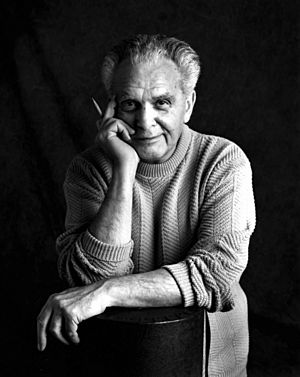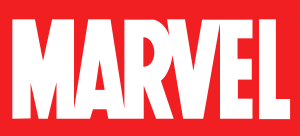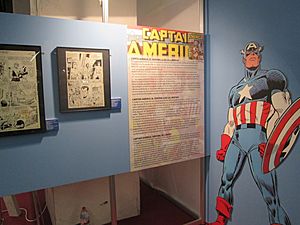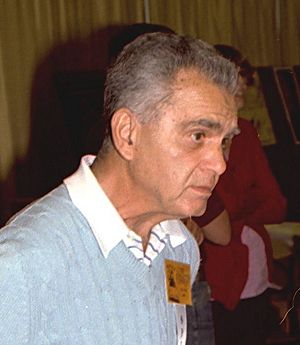Jack Kirby facts for kids
Quick facts for kids Jack Kirby |
|
|---|---|

Kirby in 1992
|
|
| Born | Jacob Kurtzberg August 28, 1917 Lower East Side Manhattan, New York City, New York, U.S. |
| Died | February 6, 1994 (aged 76) Thousand Oaks, California, U.S. |
| Nationality | American |
| Pseudonym(s) | Jack Curtiss, Curt Davis, Lance Kirby, Ted Grey, Charles Nicholas, Fred Sande, Teddy |
|
Notable works
|
Captain America, Fantastic Four, the Fourth World titles, Hulk, Kamandi, Manhunter, Newsboy Legion, X-Men |
| Awards | Alley Award, Best Pencil Artist (1967), plus many awards for individual stories, Shazam Award, Special Achievement by an Individual (1971) |
| Spouse(s) |
Roz Goldstein
(m. 1942) |
| Children | 4 |
Jack Kirby (born Jacob Kurtzberg, August 28, 1917 – February 6, 1994) was an amazing American comic book artist, writer, and editor. He is known as one of the most important and creative people in comic book history. He helped create many famous superheroes and stories that are still loved today.
Contents
Starting Out in Comics
Jack Kirby started his career in 1935 at Fleischer Studios. There, he helped draw animated cartoons like Popeye. He then worked for the Lincoln Newspaper Syndicate until 1938.
Kirby later met Joe Simon, another talented artist. They decided to work together, creating comic books to sell to publishers. In 1941, they created the patriotic hero Captain America for Timely Comics. This company later became Marvel Comics.
Kirby's art style was very exciting. He used dramatic angles and action-packed scenes. This made Captain America a huge hit and changed how comic books were drawn. The team of Simon & Kirby became famous for their thrilling superhero comics.
After working on Captain America, they moved to DC Comics. There, they created more popular characters like the Newsboy Legion and Manhunter.
After World War II, superhero comics became less popular. So, Kirby and Simon started creating other types of stories. They are known for making the first romance comic book, Young Romance Comics. They also created crime, horror, western, and humor comics.
The partnership between Kirby and Simon ended in 1954. Kirby continued to create comics on his own. He helped update Green Arrow for Adventure Comics. He also created Challengers of the Unknown, a classic series about a group of brave adventurers.
Working with Marvel Comics
Kirby returned to Marvel Comics and began drawing many imaginative monster and science fiction stories. His unique designs for powerful creatures were very popular. In 1961, Marvel's publisher, Martin Goodman, and editor, Stan Lee, asked Kirby to start working on superhero comics again.
For the next several years, Kirby helped create almost every major character for Marvel. Some of his most famous creations include:
- The Fantastic Four
- Thor
- The Incredible Hulk
- Iron Man
- The original X-Men
- The Silver Surfer
- The Avengers
- Villains like Doctor Doom and Magneto
- The Inhumans and their hidden city, Attilan
- The Black Panther and his African nation of Wakanda
Kirby and Simon's original Captain America was brought back into Marvel's stories. Kirby liked Stan Lee's ideas to make Captain America's personality deeper.
Kirby often helped create the plots for the stories he drew. This was part of the "Marvel Method". He would add new ideas that weren't in Lee's original scripts. For example, Kirby is credited with creating the Silver Surfer, who was not in Lee's first plan for the character's appearance.
Because Kirby drew so quickly and was so good at telling stories, Stan Lee often had him just draw the pencil art. Lee would then use Kirby's drawings to write the script and add the ink, letters, and colors.
Later Career and New Creations
After some disagreements, Kirby returned to DC Comics in the early 1970s. There, he created a series of titles known as "The Fourth World". These included The New Gods, Mister Miracle, and The Forever People.
He also created other unique books like OMAC, Kamandi, and The Demon. Many characters from this time, such as the demon Etrigan and the villain Darkseid, are now important parts of the DC universe.
Later, Kirby returned to Marvel Comics. He both wrote and drew Captain America. He also created Devil Dinosaur and The Eternals. He even adapted the movie 2001: A Space Odyssey into a comic book series. Eventually, he left Marvel and comic books to work in animation. He designed characters for shows like Turbo Teen and Thundarr the Barbarian.
A new comic book publisher called Pacific Comics made a special deal with Kirby. They published his series Captain Victory. This deal was important because Kirby kept the copyright for his creation and earned money from it. This helped other comic book creators get similar rights for their own work.
Jack Kirby's Legacy
Jack Kirby is widely seen as one of the greatest and most important artists in comic book history. He created an incredible amount of art. It's estimated that he drew over 25,000 pages of comics in his lifetime. He also made hundreds of comic strips and sketches. Besides comics, he created paintings and concept art for Hollywood films.
In 1985, it was discovered that many pages of Kirby's original artwork had been "lost" by Marvel Comics. The Kirby Awards were named in his honor to celebrate great achievements in comics.
In the Superman: The Animated Series TV show, the character Dan Turpin was designed to look like Jack Kirby.
Phantom Force was the last comic book Jack Kirby worked on before he passed away. The story was based on an idea for a Bruce Lee comic from 1978.
Jack Kirby died on February 6, 1994, at the age of 76, from heart failure. He was buried in Westlake Village, California.
Images for kids
-
Captain America Comics #1 (March 1941). Cover art by Kirby and Joe Simon.
-
Fantastic Four #72 (March 1968). Cover art by Kirby and Joe Sinnott, showing Kirby Krackle.
See also
 In Spanish: Jack Kirby para niños
In Spanish: Jack Kirby para niños










